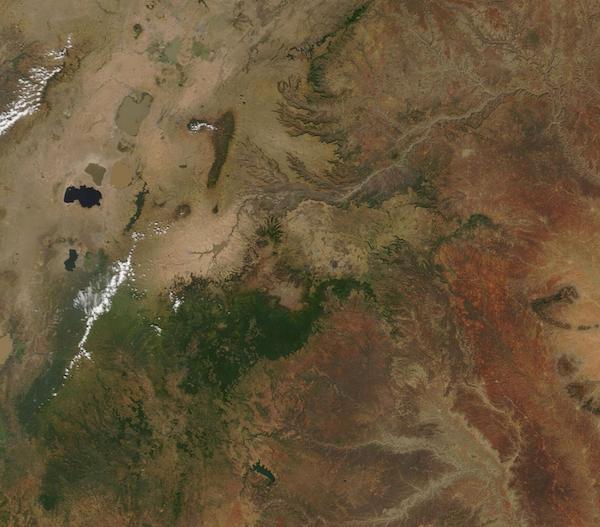Images
January 19, 2021 - Ethiopia's Bale Mountains
Tweet
A slogan for Ethiopia’s Bale Mountains National Park reads “One Park, Many Worlds”—a tribute to the biodiversity that thrives in the five different ecological zones found in the Bale Mountains. These zones include the Northern (Gaysay) Grasslands, juniper woodlands, Afroalpine meadows, Harenna forest, and the Erica Belt of moorlands and forest. The varied habitat creates a home for a wide variety of species: 78 mammal, 12 reptile, 17 amphibian, 310 bird, and 1,300 flowering plants.
The Bale Mountains are found about 250 miles (400 km) southeast of Ethiopia’s capital city, Addis Ababa. The range was formed from lava outpourings, layer by layer, ultimately raising the Sanetti Plateau to a towering height. The plateau spreads across thousands of square kilometers in southeastern Ethiopia and much of it rises to 3,000 meters (10,000 feet) above sea level. It is the largest area of Afroalpine habitat on the African continent.
Sitting on top of the high base of the Sanetti Plateau, several volcanic cones reach more than 4,000 meters (13,123 feet) high. It is here, in these dramatic highlands, that Tullu Demtu rises to 4,377 meters (14,360 feet) to capture the title of the second-highest mountain in Ethiopia. In the south, the height of the Plateau drops rapidly from 4,000 meters (13,123 feet) to 2,000 meters (6,562 feet) in just 8 km (5 miles). This steep drop is called the Harenna escarpment and leads to the second-largest section of moist tropical forest in Ethiopia—the Harenna forest. It is also the largest cloud forest in the country and home to the largest natural stand of wild coffee genetic stock—the plants that gave rise to famous Ethiopian coffee. The northern reaches of the Sanetti Plateau hold the Gaysay grasslands and juniper woodlands.
The Bale Mountains are an area of critical importance for many reasons. Many endemic and endangered species call this region home, including the elegant mountain nyala, reedbuck, the African Golden Wolf, and the rare Ethiopian wolf. More than 40% of the 1,000 known species of medicinal plants found in Ethiopia live in these mountains. The biodiversity is so impressive that, according to UNESCO, it has been estimated that more mammal species would go extinct if the habitats of the Bale Mountains to disappear than if any other area of equivalent size on the globe were to disappear. In addition, more than 12 million people and their livestock that live in southeastern Ethiopia, northern Kenya, and Somalia, rely on water that originates from this mountainous region.
Image Facts
Satellite:
Terra
Date Acquired: 1/8/2021
Resolutions:
1km (44.1 KB), 500m (164.8 KB), 250m (524.4 KB)
Bands Used: 1/8/2021
Image Credit:
MODIS Land Rapid Response Team, NASA GSFC
Tweet
A slogan for Ethiopia’s Bale Mountains National Park reads “One Park, Many Worlds”—a tribute to the biodiversity that thrives in the five different ecological zones found in the Bale Mountains. These zones include the Northern (Gaysay) Grasslands, juniper woodlands, Afroalpine meadows, Harenna forest, and the Erica Belt of moorlands and forest. The varied habitat creates a home for a wide variety of species: 78 mammal, 12 reptile, 17 amphibian, 310 bird, and 1,300 flowering plants.
The Bale Mountains are found about 250 miles (400 km) southeast of Ethiopia’s capital city, Addis Ababa. The range was formed from lava outpourings, layer by layer, ultimately raising the Sanetti Plateau to a towering height. The plateau spreads across thousands of square kilometers in southeastern Ethiopia and much of it rises to 3,000 meters (10,000 feet) above sea level. It is the largest area of Afroalpine habitat on the African continent.
Sitting on top of the high base of the Sanetti Plateau, several volcanic cones reach more than 4,000 meters (13,123 feet) high. It is here, in these dramatic highlands, that Tullu Demtu rises to 4,377 meters (14,360 feet) to capture the title of the second-highest mountain in Ethiopia. In the south, the height of the Plateau drops rapidly from 4,000 meters (13,123 feet) to 2,000 meters (6,562 feet) in just 8 km (5 miles). This steep drop is called the Harenna escarpment and leads to the second-largest section of moist tropical forest in Ethiopia—the Harenna forest. It is also the largest cloud forest in the country and home to the largest natural stand of wild coffee genetic stock—the plants that gave rise to famous Ethiopian coffee. The northern reaches of the Sanetti Plateau hold the Gaysay grasslands and juniper woodlands.
The Bale Mountains are an area of critical importance for many reasons. Many endemic and endangered species call this region home, including the elegant mountain nyala, reedbuck, the African Golden Wolf, and the rare Ethiopian wolf. More than 40% of the 1,000 known species of medicinal plants found in Ethiopia live in these mountains. The biodiversity is so impressive that, according to UNESCO, it has been estimated that more mammal species would go extinct if the habitats of the Bale Mountains to disappear than if any other area of equivalent size on the globe were to disappear. In addition, more than 12 million people and their livestock that live in southeastern Ethiopia, northern Kenya, and Somalia, rely on water that originates from this mountainous region.
Image Facts
Satellite:
Terra
Date Acquired: 1/8/2021
Resolutions:
1km (44.1 KB), 500m (164.8 KB), 250m (524.4 KB)
Bands Used: 1/8/2021
Image Credit:
MODIS Land Rapid Response Team, NASA GSFC




